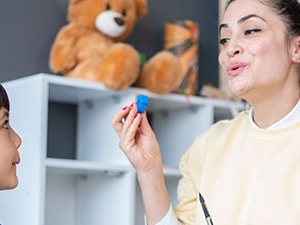4 Tips for Supporting Caregivers of Autistic Children
February 17, 2023
6 min. read

In recent years, the therapy community has begun to have a deeper understanding of autism as a different neurotype rather than a disorder to be fixed. However, many parents and caregivers may be unfamiliar with this concept, which can make caring for an autistic child confusing, overwhelming, and sometimes scary.
Because of this, we as therapists must change our mindset when approaching therapy with autistic clients, as well as change the language and tools we use with caregivers to best support autistic learning styles.
To help those caregivers, I like to provide simple, straightforward resources to take home, watch repeatedly, and try out to help build their confidence in interacting with their child. Ill share some of the resources you can share with caregivers via Medbridge throughout this article.
Here is a basic flow of steps you can follow to support neurodiversity-affirming intervention for autistic children:
Sensory self-regulation: A regulated child can access their optimal learning zone.1
Joint attention: Sharing in an experience leads to greater joy and motivation to engage in future play activities.2-4
Imitation: This is foundational for play and communication skills.2,4
Building a meaningful vocabulary: This involves supporting vocabulary growth through play that is meaningful for the child.5-6
Sensory Self-Regulation & Communication
At the very basis of communication for many autistic individuals is sensory self-regulation.
When childrens sensory systems are not regulated, they are not able to access their optimal learning zone and may engage in self-stimulating behaviors or repetitive movements that can help them self-soothe, also known as stimming. This could include finger flicking, rocking back and forth, humming and repeating words or phrases.
Although stimming is beneficial for regulating the childs sensory system and serves an important role in emotional regulation, it may interrupt communication interactions while the child is working toward regulation. Therefore, it falls on us to support regulation before we can build communication skills.
Bearing in mind that every childs sensory needs are different, here are five basic ways you can support self-regulation for your clients:
Give the child a chance to move around a little.
Give the child something to touch or squeeze.
Have the child do heavy work activities, such as bear crawls.
Set up the childs environment to support their learning.
Know the childs triggers.
Once a child is regulated, their sensory system is processing information in a way that allows them greater access to communication. For an autistic child, play and communication often look very different than they do for neurotypical children. It is important to follow a childs lead when helping them begin to communicate in order to increase motivation and engagement.
To better help the caregivers of your autistic clients learn how to support regulation and play skills, you can share patient education resources from Medbridge, such as Self-Regulation Strategies (as seen below) and Following Your Childs Lead. Find these resources and more by searching the Medbridge Patient Education Library, available for Premium subscribers.
Joint Attention and Engagement
My client is regulated and ready to learnnow what? Enter: joint attention.
"Joint attention may feel like a nebulous concept. Ive been asked countless times what I mean when I try to explain how important joint engagement is when building communication skills.
To boil it down, joint attention can be described as truly sharing an activity.
For many young autistic children, objects are more interesting than peoplewhich can make joint attention very difficult to achieve. This is all the more reason to make sure caregivers are on board and reinforcing activities to build joint engagement in the home environment.
For my autistic clients, sensory self-regulation and joint engagement are difficult but necessary foundational skills to achieve before I can begin to focus on other communication targets, such as imitation and building a meaningful vocabulary. When we have regulated children who are motivated to engage with us, we can incorporate imitation skills and start narrating, labeling, and modeling to support significant vocabulary growth.
For example, I might begin by imitating what a child is doing and follow their lead in play (as seen in the Following Your Childs Lead video below) to increase their engagement with me. If I am willing to imitate the unique way an autistic client is playing (for example, lining up toys), I am far more likely to gain their attention because I am joining their world.
Once Im in that world, I can start to add in my own play ideas and build joint attention by sharing in the play experience. For my client who lines up toys, I might help him line them up and then knock them down with a fun, excited, Ready, set, go! I can repeat this play routine as many times as necessary until the client feels comfortable and/or joins in by imitating or adding to my play routine.
This video below in Medbridge's Patient Education Library, "What Is Joint Attention?" highlights its importance as a basis for communication and provides parents with the needed tools to engage their autistic children in play activities, even if it may look different from what they expect. When parents understand how to engage their children in activities that build joint attention, this allows them to enter their childs world and participate in communication exchanges based on motivating play.
Imitation as a Foundation
Were officially sharing this play experience, but now I need to expand imitation and vocabulary to increase my clients learning.
As imitation skills start to build, we can expand play even further. This gives us more opportunities to build meaningful vocabulary by narrating play, providing models of labels, actions, and core words, and asking open-ended questions as seen in the video below in Medbridge's Patient Education Library, "Building a Meaningful Vocabulary."
Once Ive begun to incorporate this level of play and language modeling into my therapy sessions, I can assign caregivers the same video to watch and incorporate at home.
Utilizing Resources
How can we support confident, at-home practice and carryover of skills using readily available resources?
As therapists, we may use a variety of different strategies and activities to support our clients communication skills. It is equally important that a family feels well-equipped to support their childs communication and learning in the home environment.
As our understanding of autistic communication development increases, its important that we continue to expand and adjust our therapy tools and approach as best we can to support our clients. This includes utilizing current resources, challenging our mindsets, and asking autistic voices for their perspectives. In addition to the methods we use in the therapy room, supporting families with home practice is an essential part of this growth and development.
By sharing resources like the ones featured here with your clients caregivers, you can start building the bridge between the therapy room and the home as we support the communication development of the autistic children we work with.
Below, watch Jenny L. Clark discuss the importance of playtime in early childhood development in this brief clip from her MedBridge course “Purposeful Play Solutions for Sensory Modulation in Early Intervention."






